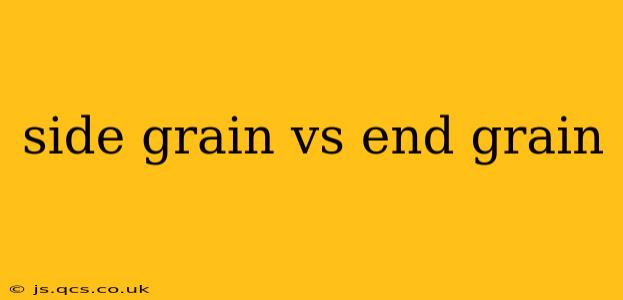Choosing the right type of wood for a project depends on many factors, but understanding the grain orientation is crucial. This article will explore the key differences between side grain (also known as flat grain or plain-sawn) and end grain, highlighting their respective strengths and weaknesses. We'll also address some frequently asked questions to provide a comprehensive understanding of this important woodworking concept.
What is Side Grain (Flat Grain)?
Side grain wood is cut parallel to the growth rings of the tree. Imagine slicing a loaf of bread – each slice represents a board cut from side grain. This method is the most common and efficient way to produce lumber, resulting in wider boards. The grain pattern appears as relatively straight, parallel lines running the length of the board.
Advantages of Side Grain:
- Ease of Working: Side grain is generally easier to work with using hand tools and machines. It's less likely to splinter or tear out during cutting or shaping.
- Cost-Effective: Due to its efficiency in production, side-grain lumber is typically less expensive than end grain.
- Aesthetic Appeal: The consistent, parallel grain pattern can create a clean, uniform look, desirable in many applications.
Disadvantages of Side Grain:
- Less Durable: Compared to end grain, side grain is more susceptible to wear and tear, especially on surfaces exposed to friction or impact.
- Greater Expansion and Contraction: Side grain is more prone to expansion and contraction with changes in humidity, potentially leading to warping or cracking.
What is End Grain?
End grain wood is cut perpendicular to the growth rings of the tree. Think of cutting across the loaf of bread – each cut surface displays the end of the grain. This method yields smaller pieces but showcases the wood’s full cellular structure.
Advantages of End Grain:
- Exceptional Durability: End grain is significantly more durable and resistant to wear than side grain, making it ideal for high-traffic areas or surfaces subject to heavy use.
- Superior Stability: Due to its cellular structure, end grain is less prone to expansion and contraction, making it more dimensionally stable.
- Unique Aesthetic: The unique circular patterns visible in end grain create a visually striking and textured surface.
Disadvantages of End Grain:
- Difficult to Work With: End grain can be challenging to work with, particularly when using hand tools, as it tends to splinter more easily. Machine work also requires careful attention.
- Higher Cost: The inefficiency of producing end-grain boards typically leads to a higher cost compared to side grain.
- Limited Sizes: End-grain pieces are generally smaller in size, limiting their applications.
How is the Grain Orientation Determined?
The orientation of the grain is determined by how the log is cut. Different cutting methods result in varying grain patterns and properties. Understanding these methods is vital in selecting the appropriate wood for a particular application.
Which Grain is Better for Cutting Boards?
End grain is almost universally preferred for cutting boards. Its superior durability and resistance to wear make it far more resilient to knife cuts and scratches. The cellular structure of the end grain also helps to seal the wood, preventing moisture absorption and bacterial growth.
Which Grain is Better for Furniture?
The best grain orientation for furniture depends on the specific piece and its intended use. Side grain is commonly used for many furniture components due to its ease of working and cost-effectiveness. However, for areas subjected to high wear, such as tabletops or chair seats, end grain might be a better choice for increased durability.
What are the Different Types of Grain Patterns?
Beyond side grain and end grain, there are other types of grain patterns to consider:
- Quarter-sawn: This method produces a more stable and visually appealing grain pattern than plain-sawn (side grain).
- Rift-sawn: Similar to quarter-sawn, rift-sawn wood exhibits excellent stability and a unique, straight grain pattern.
Choosing between side grain and end grain ultimately depends on your project's specific needs and your priorities regarding cost, durability, and aesthetics. Understanding the characteristics of each grain orientation will help you make an informed decision and achieve the desired results.
